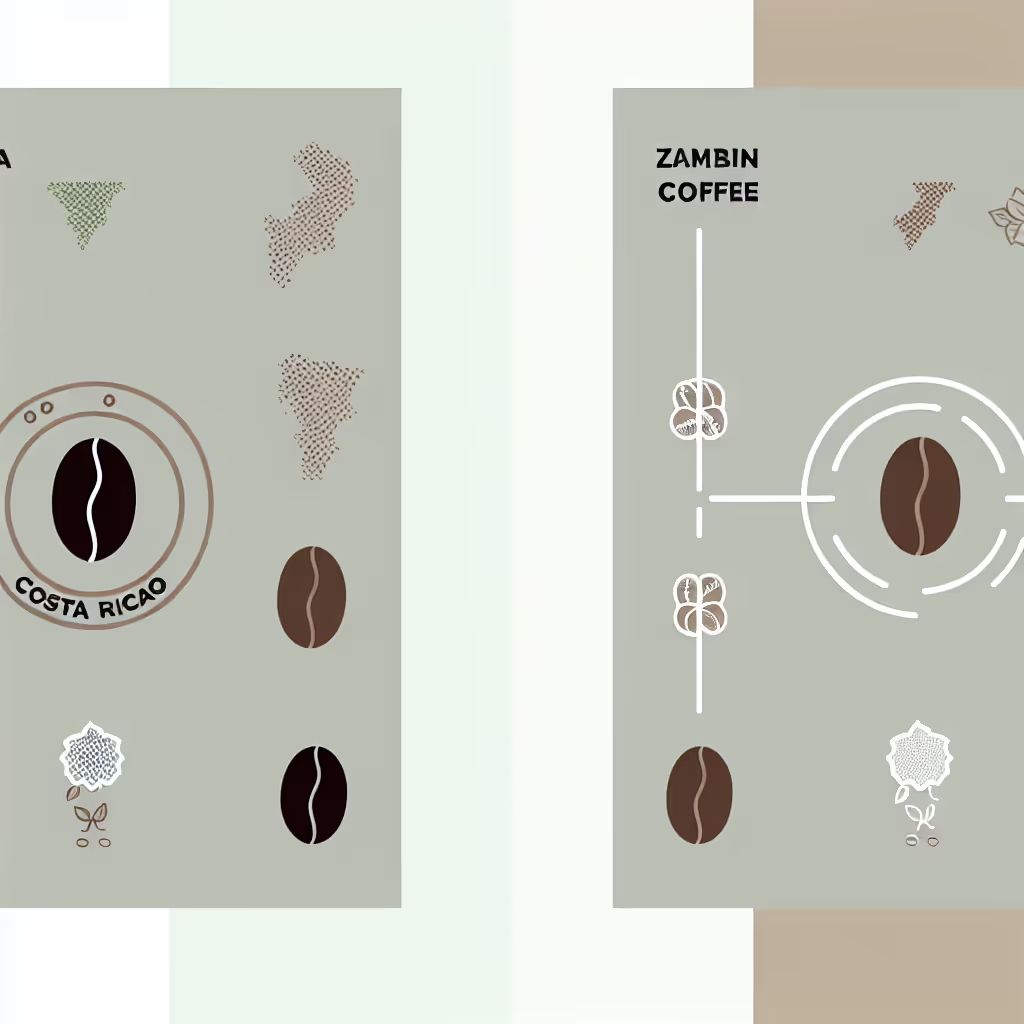Costa Rican Vs. Zambian Coffee
This comparison explores the nuanced differences between Costa Rican and Zambian coffee beans, examining their flavor profiles, growing conditions, and brewing methods to help coffee enthusiasts make informed choices.

Brief Description
Costa Rican coffee is renowned for its clean, bright, and well-balanced profile. Grown in ideal conditions with rich volcanic soils and high altitudes, these beans offer a perfect harmony of acidity and body. The country's commitment to quality and sustainability shines through in every cup, delivering a consistently excellent coffee experience that's both complex and approachable.
Zambian coffee is a hidden gem in the African coffee scene, known for its smooth, balanced profile with a gentle acidity and medium body. Grown in the Northern Province, particularly around the Mafinga Hills, these beans thrive in the region's rich volcanic soils and high altitudes. Zambian coffees often exhibit a delightful complexity, featuring notes of citrus, berries, and chocolate, making them a favorite among specialty coffee enthusiasts seeking unique African flavors.
Importance of Comparison
Comparing Costa Rican and Zambian coffee is crucial for coffee lovers seeking to expand their palate beyond mainstream origins. These two regions offer unique flavor profiles and growing conditions that contribute to their distinct characteristics. Understanding the differences helps consumers make informed decisions based on their taste preferences and brewing methods, while also supporting diverse coffee-producing regions.
Key Attributes
Origin
Costa Rican
Zambian


Consumer Guide
When choosing between Costa Rican and Zambian coffee, consider your flavor preferences and brewing methods. Costa Rican coffee offers a clean, bright profile with citrus, honey, and chocolate notes, ideal for pour-over and espresso. Zambian coffee presents a smooth, balanced taste with berry and chocolate undertones, excellent for French press and pour-over. Both origins thrive at similar altitudes (1200-1800m) and offer various processing methods. Costa Rica's larger production (87,000 metric tons) ensures wider availability, while Zambia's smaller output (5,000 metric tons) offers a more exclusive experience. For a classic, well-balanced cup, opt for Costa Rican; for a unique African flavor profile, choose Zambian.
Expert Opinions
Coffee expert Maria Rodriguez notes, 'Costa Rican coffee exemplifies consistency and balance, while Zambian coffee offers a exciting, lesser-known African profile.' Roaster John Smith adds, 'The citrus notes in both origins create an interesting comparison. Costa Rica's brightness is more pronounced, while Zambia's citrus is gentler, complemented by berry undertones.' Both experts agree that these origins showcase the diversity of coffee flavors and are excellent choices for single-origin enthusiasts.
FAQs
Costa Rican coffee is known for its clean, bright profile with prominent citrus, honey, and chocolate notes. Zambian coffee offers a smooth, balanced taste with gentle citrus, berry, and chocolate flavors. Both origins share citrus and chocolate notes, but Costa Rican tends to be brighter, while Zambian has a unique berry component.
Both Costa Rica and Zambia grow coffee at similar altitudes, typically between 1200-1800 meters. They both benefit from rich volcanic soils, which contribute to the complexity of their flavor profiles. The main difference lies in their geographical locations, with Costa Rica's Central American climate differing from Zambia's African terroir, influencing the subtle nuances in taste.
Both Costa Rican and Zambian coffees are versatile and work well with various brewing methods. Pour-over, French press, and espresso are recommended for both origins. Pour-over methods can highlight the bright, clean flavors of Costa Rican coffee and the complex notes of Zambian coffee. French press can enhance the body of both, while espresso can create a rich, concentrated experience.
Costa Rican coffee is more widely available due to its larger annual production of about 87,000 metric tons. Zambian coffee, with an annual production of around 5,000 metric tons, is less common and may be considered more exclusive. This difference in availability can affect pricing and ease of finding these coffees in local shops or online retailers.
Costa Rican coffee is unique for its consistently high quality and well-balanced profile, a result of strict regulations and ideal growing conditions. Zambian coffee stands out as a lesser-known African origin, offering a smooth, balanced cup with distinctive berry notes not commonly found in other regions. Both origins showcase the diversity of coffee flavors and provide alternatives to more common coffee-producing countries.
Both Costa Rica and Zambia utilize similar processing methods, including washed, natural, and honey processing. However, Costa Rica has a longer history of experimenting with these methods, particularly honey processing. Zambia is increasingly adopting diverse processing techniques, but washed and natural methods are more common. The choice of processing method can significantly impact the final flavor profile of the coffee from both origins.
Conclusion
Costa Rican and Zambian coffees offer unique experiences for coffee enthusiasts. Costa Rican beans provide a consistently excellent, bright, and well-balanced cup with prominent citrus and honey notes, ideal for those seeking a classic, high-quality coffee. Zambian beans present an opportunity to explore a lesser-known African origin with smooth, balanced flavors and intriguing berry undertones. Both origins shine in various brewing methods and showcase the diversity of coffee flavors. Whether you prefer the tried-and-true excellence of Costa Rican coffee or the exciting uniqueness of Zambian beans, both options promise a delightful journey for your taste buds.






